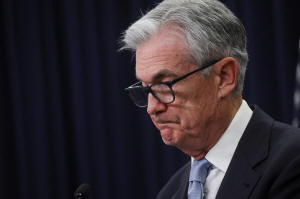Fed Chair Powell faces tough communications task on rate cuts ahead
 Send a link to a friend
Send a link to a friend
 [January 31, 2024] By
Ann Saphir [January 31, 2024] By
Ann Saphir
(Reuters) - Federal Reserve Chair Jerome Powell has a tough task on
Wednesday as he wraps up the U.S. central bank's first policy meeting of
2024: signaling an end to interest-rate hikes and teeing up future cuts
without unleashing financial market exuberance that could undermine
progress on inflation.
On one level the job is straightforward. Though the Fed has left its
benchmark rate at between 5.25% and 5.5% since July and is expected to
keep it there on Wednesday, its policy statement has continued to
include a reference to "additional policy firming" as a reminder that
any future adjustments would be upward.
Many analysts expect the Fed to delete that phrase this time around.
Powell laid the groundwork for the change last month, when he said
policymakers think another rate hike is unlikely to be needed.
"It’s become dated," said Oxford Economics' Ryan Sweet, citing quickly
cooling inflation.
Dropping it would give room to cut rates as soon as March if price
pressures or economic growth ease faster than expected, said High
Frequency Economics' Rubeela Farooqi - though she, like many economists,
believe rate cuts won't start until June.
But analysts disagree on what the Fed will say instead, in part because
there is such wide agreement that removing the phrase will be seen not
just as opening the door to a rate cut, but practically walking through
it. A resulting rally in markets could ease financial conditions and
encourage spending and investment that could potentially reignite waning
price pressures.

To forestall that possibility, Fed policymakers may opt to characterize
current policy as "sufficiently restrictive" or add a word like
"patient" or "cautious" to signal a longer hold at the current
policy-rate level, analysts said.
Several economists expect the Fed simply to swap in a more neutral
phrase for coming moves, such as "in determining appropriate policy" or
"any future adjustments," and rely on Powell, in his post-meeting press
conference, to clarify what that means.
But change is fraught.
"The risk is for markets to run with a generic 'adjustments' line as a
signal that March is very much on the table," wrote economists at BNP
Paribas, whose view is that while it's a close call they think the
"firming" phrase will stay, given recent Fed official commentary.
Removing it, even with the addition of a promise of patience, "would
heighten focus on the press conference, potentially complicating
Powell’s task," they wrote.
CURBING ENTHUSIASM
Powell is known for his plainspoken explanations of complicated economic
dynamics and an unruffled demeanor in the face of sharp political
criticism.

[to top of second column] |

U.S. Federal Reserve Board Chair Jerome Powell holds a news
conference after the Fed raised interest rates by a quarter of a
percentage point following a two-day meeting of the Federal Open
Market Committee (FOMC) on interest rate policy in Washington, U.S.,
March 22, 2023. REUTERS/Leah Millis/File Photo

Dealers on Wall Street assess communications under his watch as
being more effective than under either of his two most recent
predecessors.
But he's had his share of miscues and miscalculations.
In October 2018 he signaled more rate hikes ahead despite what
investors perceived as a swiftly weakening outlook. Then in 2021 he
stuck with calling inflation "transitory" despite accumulating data
that it was gaining more lasting traction.
Toward the end of that year he retired "transitory" and moved to
slow the Fed's bond purchases to prepare for eventual rate hikes,
but critics blame the subsequent climb in inflation to 40-year highs
in part on the Fed not starting its rate-hike campaign until March
2022.
The picture is now dramatically different. By some measures
inflation has been at the Fed's 2% target for months now, though by
the yardstick the Fed targets, the annual change in the personal
consumption expenditures price index, it is still above target at
2.6%.
But complicating matters is the strong consumer spending that helped
the economy grow 3.1% last year, measured on a fourth quarter to
fourth quarter basis, versus the 2.6% Fed officials penciled in at
their last public projections, published mid-December.
That's despite the Fed's aggressive interest rate hikes that, at the
start of 2023, most economists and the Fed's own staff thought would
trigger a recession.
"The consumer has been downright defiant," says KPMG's Diane Swonk,
and that will keep officials from projecting too much confidence in
the timing of rate cuts. "Powell will be cautious to curb his
enthusiasm at the press conference so that he does not inadvertently
trigger a major financial market rally," she said.

Last month Fed policymakers signaled they saw 75 basis-points of
rate cuts this year as likely appropriate; Swonk says that by March,
they may up that forecast to a full percentage point, and start
delivering reductions in May.
"The Fed is trying to normalize rates for a robust economy, not
overstimulate," she said. "That is a tough line to walk."
(Reporting by Ann Saphir; Editing by Dan Burns and Andrea Ricci)
[© 2024 Thomson Reuters. All rights
reserved.]
This material may not be published,
broadcast, rewritten or redistributed.
Thompson Reuters is solely responsible for this content. |